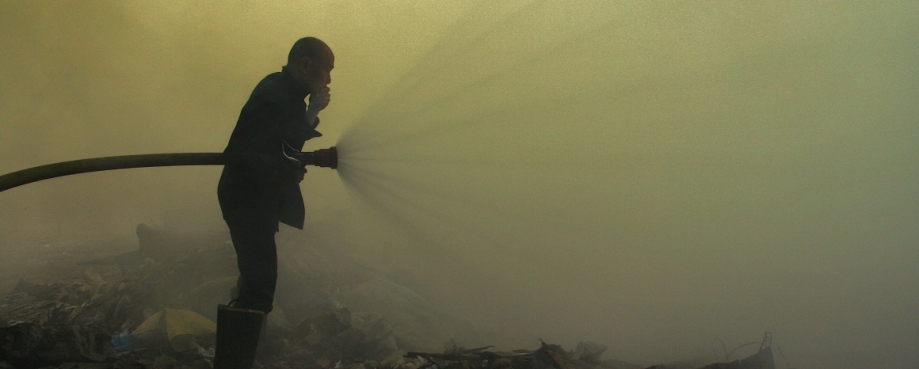
In this guest blog, ETI trainer Stirling Smith says why he is waiting for the next Rana Plaza to happen in India - and why workers are protesting. In India and elsewhere.
Stories in the UK media about India recently have focussed mainly on the royal visit and demands for the return of the Kohinoor diamond.
So you might have missed a few more challenging stories.
Flyover collapse in Kolkata
On 31 March, a flyover being built in Kolkata collapsed killing at least 23 people.
As this happened during elections to the state assembly, accusations and counter accusations flew between the political parties. As I have also pointed out in several previous blogs, it is quite common for buildings to collapse during construction in India. Or after they are built too.
After the collapse, the Indian press has exposed that so-called syndicates control the supply of building materials. In plain language, you have to buy your cement from the mafia, who aren’t too fussed about the quality.
Anybody got a supplier in West Bengal? Oh dear.
Fire and fireworks tragedies in New Delhi and Kerala
The National Museum of Natural History in New Delhi was totally gutted by a fire on 26 April. Now this is a prestige institution in the capital, under the direct control of the government, and a fire completely destroyed it. Now imagine a garment factory in somewhere like Bangalore, or Gurgaon.
The museum fire was just a few weeks after a fireworks display at a temple in Kerala killed more than 100 people.
Permission for the fireworks display had been denied, but it went ahead. No surprise, really.
In Sivakasi, in the neighbouring state of Tamil Nadu, 40 workers were killed and more than 70 injured in 2012 in a fireworks factory which did not have a valid licence.
Sourcing fireworks for Bonfire Night from India? Oh dear.
UK brands should look long and hard at factories in their Indian supply chain
My point is all the issues that were highlighted in the garment industry in Bangladesh after Rana Plaza are there in spades in India.
Dreadful building standards. A criminally lax approach to fire hazards.
So far, there has not been a big factory collapse or fire in India - or at least high street brands have not been implicated.
But just keeping your fingers crossed and hoping it is not going to happen in your supply chain is not really an adequate strategy.
It’s time for UK brands to take a long hard look at their Indian supply chain.
Workers take to the streets
Now at this point, regular readers of this blog (yes, honestly, there are some) will be thinking: he hasn't mentioned the workers yet. Well here they come. Another news story you may not have read.
Garment workers in Bangalore took to the streets on 19 April, storming a police station and blocking the national highway to Chennai. They were protesting against changes in the Provident Fund (PF) Rules.
To summarise the story:
- PF deductions should be made from workers’ wages, and employers also have to pay into what is in essence a savings scheme.
- The proposed changes would have made to harder for workers to access their PF pot.
- The government has since withdrawn the rule changes.
The workers were not called out on the streets by trade unions. Garment factories in Bangalore used by western brands are just as allergic to any form of worker voice as their colleagues in Bangladesh. It was a spontaneous upsurge of worker anger, boiling up against a government they don’t trust.
Garment workers could not strike against the employer, but it was okay to protest about the government – it was a target they could risk.
Keeping unions out of a factory does not stop workers taking action
As I keep telling managers, keeping trade unions out of your factory does not stop workers taking action.
Sometimes it is quiet sabotage, or just absenteeism, or mass fainting (Cambodia) or – my favourite – stopping work because the factory is haunted by a ghost (Philippines and Bangladesh).
There have been similar spontaneous worker actions in Vietnam. In April last year, workers closed the national highway between Ho Chi Minh City and Hanoi – and the issue was exactly the same – workers were protesting changes to personal savings rules.
Workers of the World, unite! The old slogan lives.
A workforce treated with contempt
Workers in India are not a happy bunch. According to one survey, 31 per cent of Indian workers are “actively disengaged”. That doesn’t mean they grumble around the water cooler. They are really p****d off.
So p****d off in fact, that they are ready to kill their managers.
The All India Organisation of Employers published a report in 2014 that listed a series of incidents where managers were killed by workers.
And it admitted that hyper-exploitation of workers was an underlying cause.
So, as well as lax building standards and non-existent fire safety, what else do Indian and Bangladesh have in common?
A workforce treated with total contempt by employers.
And a workforce waiting for the opportunity to get their own back.
Don’t say I didn’t warn you.
